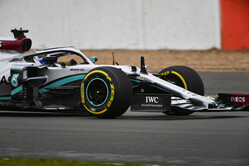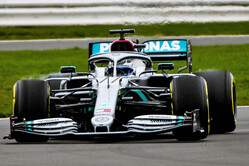


14/02/2020
NEWS STORY
 James Allison and engine boss, Andy Cowell give insight into the Mercedes W11, revealing that there will be few significant changes before Melbourne.
James Allison and engine boss, Andy Cowell give insight into the Mercedes W11, revealing that there will be few significant changes before Melbourne.
"The shakedown has always been important, but it is particularly precious this year. It's our last chance to make sure all is well ahead of the first official day of Winter Testing. If all goes well in the shakedown then we will be well placed to roll out the garage at nine o'clock in Barcelona and just start hitting the laps," said technical director, James Allison as Valtteri Botas took to the track in Mercedes 2020 contender. "With a shorter winter testing programme, that last ticking everything off at the shakedown is proportionally more important so we are determined to squeeze every drop of goodness from it that we can.
The W11 is an evolution of last year's contender - the car that won Mercedes its historic sixth consecutive double championship. The team has looked at a myriad of areas to improve the car and has changed the vast majority of the over 10,000 parts to extract more performance. The W11 is expected to become the fastest Mercedes race car ever built.
"The regulations stayed largely the same for the new year, so for us it was all about trying to make sure that we don't run out of development steam on a package that worked pretty well for us last year," said Allison. "We wanted to change aspects of the concept of the car - aspects that would be completely impossible to change within a season - to give us a more fertile platform for the new season. We tried to make a few well-chosen architectural changes to keep the development slope strong even though the regulations are now a little bit longer in the tooth."
In addition to many detail changes and smaller improvements, the team has introduced three larger changes - one at the front, one at the middle and one at the back of the car.
 "At the front we have accepted more structural complexity around the uprights and wheel rims in order to provide a higher performance assembly overall," said James. "In the middle of the car we have followed the pitlane trend by moving our upper side impact tube to the lower position and banking the aerodynamic gain that comes with this layout. At the rear of the car we have gone for an adventurous suspension layout in order to free up aerodynamic development opportunity. All three investments were improvements in their own right, but their real effect is to mobilize a raft of secondary aerodynamic gains both during the winter and, we hope, across the season to come."
"At the front we have accepted more structural complexity around the uprights and wheel rims in order to provide a higher performance assembly overall," said James. "In the middle of the car we have followed the pitlane trend by moving our upper side impact tube to the lower position and banking the aerodynamic gain that comes with this layout. At the rear of the car we have gone for an adventurous suspension layout in order to free up aerodynamic development opportunity. All three investments were improvements in their own right, but their real effect is to mobilize a raft of secondary aerodynamic gains both during the winter and, we hope, across the season to come."
In 2019, the team brought a significant upgrade to the car after the first week of testing that changed the look of the Melbourne car quite significantly compared to the launch car. This year, the race trim will be much closer to the car that is running at Silverstone today.
"We will still have upgrades for Melbourne that will come in the second week of testing, but the 'entire new car' approach of 2019 won't feature," said James. "Last year, the regulations were changed quite significantly, and they were decided quite late in the year. Under those circumstances, doing a launch car and a week two car gave us the chance to build the maximum amount of learning into our Melbourne car. With the regulations being more mature this year and with the opening stab of the 2020 development already being at the same level as the finish of last year's car, repeating last year's approach would not make sense."
Similar to the development on the chassis side, the all-new power unit - christened Mercedes-AMG F1 M11 EQ Performance - is an evolution as the regulations stayed largely the same.
However, while the chassis regulations go into their second year of relative stability, the technical regulations around the power unit have not had any major changes since the introduction of the current generation of 1.6 litre V6 hybrid engines in 2014, making the hunt for performance increasingly difficult.
"We have had to develop an even wider area of the PU. We have looked at every single system," said Andy Cowell, Managing Director of Mercedes-AMG High Performance Powertrains. "We have worked on a huge array of projects, and when summed together they will hopefully help propel the car around the track quicker and give the aerodynamics team more opportunities to improve as well."
In the six years since its introduction, the Mercedes PU has made significant progress not just in terms of power output and reliability, but also in terms of its efficiency. From 2014 to today, the thermal efficiency has improved from about 44 percent to over 50 percent. Thermal efficiency describes an engine's ability to convert fuel energy into useful work. Achieving more than 50 percent means that that more than half of the energy in the fuel can be used to propel the car - making the current F1 power unit one of the most efficient internal combustion engines ever built. A typical road car engine would usually reach about 30 percent of thermal efficiency.
Trying to come up with new solutions to improve performance and reliability for the seventh year of stable regulations is not an easy thing to do - and the success of it depends to a large extent on the right mind-set.
"There is no such thing as perfection, there is always the opportunity to improve and all of us have that mind-set," said Cowell. "We're always improving every detail - the materials, the hardware and ingredients, but also things like our design tools. You know there are areas where you can get better. Being self-critical and keeping an open mind is at the core of that mind-set."
Last year's car struggled in hot ambient temperatures and team members in both Brackley and Brixworth have worked together to improve the cooling package for the W11. In addition to larger radiators in the car, the team has focused on making the cooling more efficient by proving out higher operating temperatures for the engine.
"We are putting significant effort into making sure that all the cooling fluids on the power unit operate at a higher temperature," said Cowell. "This increases the temperature difference between that coolant fluid and the ambient temperature that we are racing in, which increases the effectiveness of the cooling system.
"That's a tough challenge though, because large parts of the engine are made from aluminium and the temperatures that we are operating at mean the material properties are decaying quite rapidly. Managing that over an eight-race distance power unit cycle is a tough engineering challenge but that's what we are striving for.
"As power unit engineers we don't just focus on crankshaft power, we also focus a tremendous amount on the packaging and reducing the overheads for the aerodynamicist, so that they can mainly focus on keeping the car planted through the corner."
Check out our Mercedes W11 gallery, here.